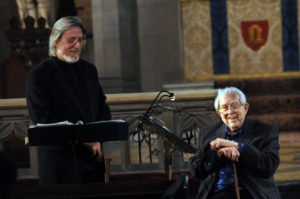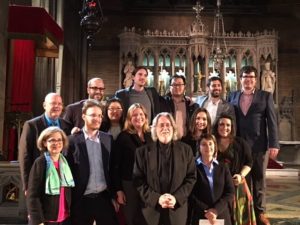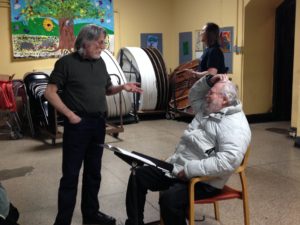Chapter 11: Working with, and Supporting Composers – From Harold Rosenbaum’s Book A Practical Guide to Choral Conducting
Comments Off on Chapter 11: Working with, and Supporting Composers – From Harold Rosenbaum’s Book A Practical Guide to Choral ConductingNovember 2, 2017 by Admin
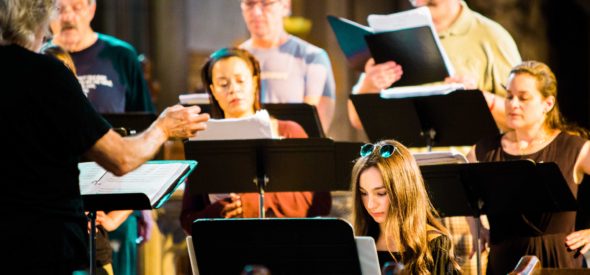
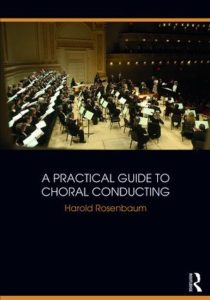 Harold Rosenbaum’s book, A Practical Guide to Choral Conducting, has been released by Routledge (available at https://www.routledge.com/A-Practical-Guide-to-Choral-Conducting/Rosenbaum/p/book/9781138058446). The following is an excerpt from Chapter 11: Working with, and Supporting Composers.
Harold Rosenbaum’s book, A Practical Guide to Choral Conducting, has been released by Routledge (available at https://www.routledge.com/A-Practical-Guide-to-Choral-Conducting/Rosenbaum/p/book/9781138058446). The following is an excerpt from Chapter 11: Working with, and Supporting Composers.
Chapter 11: Working with, and Supporting Composers
Creativity today must not be stifled or ignored: it is essential that conductors support living composers to ensure that future generations may choose from a continually growing selection of works. At the same time, it is vital for composers to understand how to interrelate with those performing their music. This chapter discusses this joining of forces, offering guidance to mutually benefit both parties. To bring these two worlds together, it facilitates their interaction by offering technical notational tips that will eliminate confusion and ease the process of preparing for performances.
It is no longer common for a choir to perform only the music of long gone composers, unless that is its stated mission. You must encourage composers to continue their creative process by including their works in your concerts. This will increase the repertoire for future generations of choral lovers to enjoy.
It is crucial that living composers and conductors not be isolated from each other, but rather interact on a regular basis. Composers obviously benefit from performances of their music emotionally and perhaps as well as financially. Conductors obviously benefit in that composers bring new and exciting music to the table, and perhaps even a world premiere, which will generate additional excitement among choir members and audience. You may even choose to commission a composer to write a piece for your choir,
When you select a composition by a living composer, there is always a chance that he/she will attend your concert as well as a rehearsal or two, so that he himself can learn what works and what doesn’t in his score. His presence and comments can help you, as well as your singers, who will be inspired by his appearance and his suggestions. Here are some tips for successful and fulfilling interactions and mutual learning experiences between the composer, you, and your choir.
Calls for Scores
Here are some guidelines you should be free to impart and impose when you reach out to composers, to make the experience easier for you from start to finish:
Submitted scores should be legible. Handwritten ones often are not. Composers should use Sibelius or Finale music notation programs.
- Composers should not send one-sided scores bound by a clip, or even worse, stapled. And the paper they write on should be thick enough to actually not fall down or curve over when placed on the piano rack.
- If the text is not public domain, a copy of the letter from the poet in which permission is given should be included.
- Portrait, not landscape. Easier to handle, especially when singers perform without music stands, which is the norm.
- Notes and words should be large enough to read without straining.
- Texts should be placed under each part, not shared among two lines.
- Meter changes should be placed in all parts, not just above the soprano part.
- There should be page numbers, measure numbers, and/or capital letters enclosed in squares on each page
Advising Composers Writing for Choirs
When commissioning young or emerging composers, conductors should offer guidance throughout their creative process. If at the point where the score is offered as a first draft or in completed form you see room for improvement, you should discuss this with the composer, who will appreciate the opportunity to learn from the feedback. Similarly, when composers send scores in response to a call for scores which arrive with similar needs for improvement, you should reach out to the composers. Of course, this outreach should be done only with scores being seriously considered, lest it turn into a full-time job!
Here are suggestions to assist you in helping the composer, and ultimately the singers.
- Along with the score, composers should include the duration of the piece, a biography, the year of completion, program notes and the original form of the text, all to make it easier both when planning a concert and when putting together the program booklet.
- It would be very useful to have the ranges of each part shown after their clef at the beginning of the piece.
- Composers should not hesitate to use footnotes, prefaces, or performance suggestions to explain uncommon or unusual notations, concepts, preferences or concerns.
- It is not necessary to repeat a metronome mark further on in the score if it has not changed. It IS necessary, when going from 4/4 to 6/8 to say eighth = eighth or quarter = dotted quarter, etc.
- If a piece begins in 4/4 the metronome marking should say that a quarter note = 60, or 84, etc., not a half note = 30 or 42, etc. In other words, the note value expressed in the tempo indication should be the number on the bottom of the meter sign.
- It is confusing to have a long note tied to an eighth or sixteenth if the intended duration is just the long note. Publishers often do that even when the score submitted to them for publication does not. It is a British tradition going back centuries. However, what if a composer really wants a singer to release the note on the “and of 1” when a whole note is tied to an eighth in 4/4 time?
- When the text is in a foreign language, especially when not in Italian, French or German (and especially when in Estonian, Danish, Polish, etc.), a pronunciation guide in the preface would be helpful, as well as a syllable by syllable phonetic guide under the text in the music.
- When there is divisi, especially extended ones, each part should have its own staff whenever possible.
-
When a composer wants a portamento and notates it with a diagonal line connecting two notes, the conductor is likely to instruct the singers to start sliding immediately. If the composer wants the sliding to occur midway through or towards the end of the note, he/she should find a way to say so.
- It is easier for audiences to hear, and for singers to do “oo”’s than ‘mm’’s, and even easier with “ah”’s. If the score has “mm” ask the composer if one of the above alternate background sounds can be substituted. Chances are the answer will be yes.
- Crescendos and decrescendos should be notated at the exact point they are to begin and end.
- If three parts crescendo from a “p” to “f” over the course of a measure, and the remaining part over the course of one beat or two, it is not necessary for a composer to put “molto crescendo” for that part. A crescendo sign is sufficient.
Read much more in the book.
More about A Practical Guide to Choral Conducting, including ordering information, at https://www.routledge.com/A-Practical-Guide-to-Choral-Conducting/Rosenbaum/p/book/9781138058446. Visit Harold at http://www.haroldrosenbaum.com/.
Comments Off on Chapter 11: Working with, and Supporting Composers – From Harold Rosenbaum’s Book A Practical Guide to Choral Conducting
Sorry, comments are closed.

